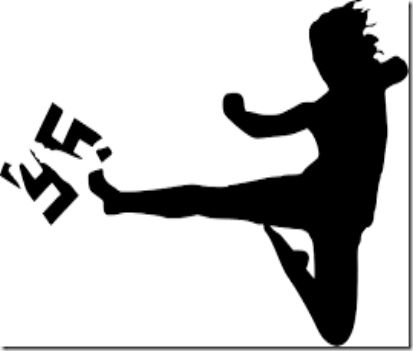Lo stato sociale di Hitler di Aly Gotz
Hitler era un socialista rigoroso e generoso grazie a queste sue virtù conquistò l' opinione pubblica.
Ricordiamoci che il Nazismo fu una dittatura che si assicurò un consenso vastissimo fino alla fine dei suoi giorni.
Origini del consenso: non il carisma di Hitler ma il denaro messo a disposizione per i bisogni della popolazione.
Ricordiamo come usciva la Germania dalla pace di Versailles: con 1/8 del suo territorio perduto (e 1/10 della sua popolazione).
I debiti per i danni di guerra fanno impallidire la tanto criticata austerity contemporanea. Un ritardo nei pagamenti costò la Ruhr e l’ iperinflazione.
Da questa situazione disperata, Hitler seppe costruire dal nulla il welfare nazista considerato da tutti un autentico gioiellino di efficienza e cura, roba da fare invidia ancora oggi a molti paesi che consideriamo avanzatissimi.
Il nazismo fu sostenuto da una nutrita schiera di intellettuali estranei alla destra tradizionalista. Si guardi solo alle biografie dei gerarchi: quasi tutti avevano fatto esperienze socialiste se non comuniste.
Ma il socialismo è dispendioso, da qui il problema principale del Furher: come finanziare il sistema?
L’ossessione di Hitler: la lotta alla povertà. La politica per l’ uguaglianza è centrale nel sistema: “l'ariano più prezioso è l'ariano più povero”. Il dovere primario del reich è pensare a lui.
Le architravi del sistema:
- Tasse fortemente progressive.
- Ferie prolungate, legislazione sul lavoro avanzata e vacanze a spese dello stato.
- Società senza classi.
- Esenzioni fiscali mirate sui bisognosi.
- Abolizione delle tasse sui lavoratori dipendenti.
- Pingui assegni familiari
- Congedi sindacali retribuiti.
- Crediti alle piccole imprese e mutui agevolati.
- Pensioni aumentate per tutti.
- Cassa malattia.
- Motorizzazione di massa con la Wolkswagen.
- Case popolari.
- Zero corruzione: l’amministrazione era una casa di vetro.
- Meritocrazia ovunque (la ricerca scientifica era un esempio).
- Generosi sussidi ai più sfortunati.
- Monopolio della scuola di stato e finanziamento generoso della stessa.
- Anche gli animali godevano di tutele.
***
Soldi per tutti, insomma… ma nel 1937, ecco la prima crisi di bilancio.
La soluzione fu triplice: 1) tanta finanza creativa, 2) guerra alla Polonia e 3) esproprio agli ebrei (già ipertassati).
I tedeschi erano un popolo razzista? No, piuttosto un popolo “comprato” grazie ad un esteso stato sociale.
I privati amici vengono agevolati (il loro aiuto verrà utile): per loro prezzi stracciati nella rivendita degli immobili sequestrati al giudeo.
Il Nazismo dura, resiste… Perché? Perché per un ariano – specie per i ceti più bassi – il nazismo è un paradiso in terra.
Shoah: omicidio di massa a scopo di rapina per finanziare uno stato sociale avanzato (troppo avanzato).
L’ideologia razzista ebbe un ruolo più di apparenza che di sostanza, intervenne a posteriori. Fu l’aspetto materialista a fungere da levatrice di questa funesta storia.
Marx tra i socialisti e Hayek tra i liberali converrebbero.
***
Hitler, del resto, non desiderava la guerra: sapeva che non aveva forze sufficienti. Alan John Percival Taylor fu il primo storico a sostenere con solidi argomenti la tesi.
Hitler occupò l’ Austria tra l’ entusiasmo degli austriaci.
Occupò la Cecoslovacchia nel silenzio della comunità internazionale, era un nuovo stato nato dalle ceneri dell’ impero di cui importava ben poco.
Per la Polonia contò sullo stesso silenzio. Il patto con l’ URSS lo rassicurava e, del resto, molti già consideravano la Polonia uno stato satellite della Germania.
E’ vero, Hitler parlava di espansione e spazio vitale ma riteneva di poter ottenere tutto questo senza la guerra. La Wermacht, del resto, non aveva piani militari.
Nel 1939 Hitler propose un tavolo della pace e rimase sconcertato dai dinieghi inglesi. Ancora nel 41 Hess tentava missioni di pace. La Francia fu tolta di mezzo perché solo la Gran Bretagna veniva considerata a quel punto come l’interlocutrice decisiva.
Hitler ingigantì la sua partita e la perse non tanto perché avesse mire espansionistiche, quanto perché fu un giocatore da “all in” (o la va o la spacca). Una questione psicologica e di strategia più che un progetto malefico ad ampio raggio.
